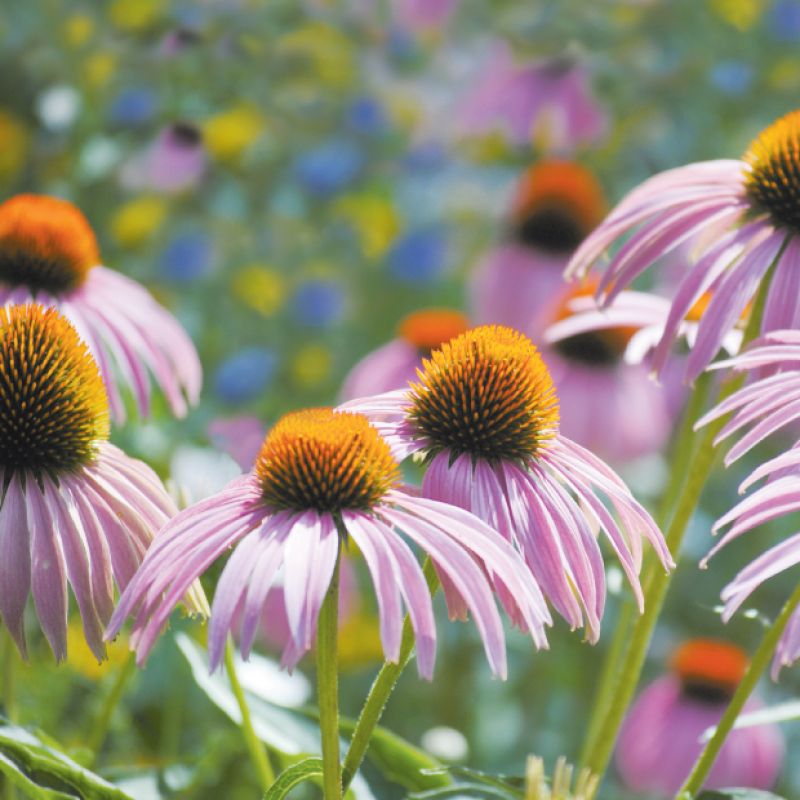
Want a gorgeous cut-flower garden without all the fuss? Then the low-maintenance, drought-tolerant coneflower (Echinacea) is a good bet. This native perennial produces large composite (daisy-like) blooms in a rainbow of colors and sizes, depending on variety. Plant them in spring or fall when temperatures are mild; once established, they will blossom from mid-summer through the first frost. Note: Echinacea is salt-sensitive, so coastal residents should plant it in a container.
Enjoy them freshly cut in a vase or preserve them for later use by drying (see sidebar). A bonus: these sturdy blooms are butterfly, bee, and bird magnets, providing much-needed food sources of seed and nectar. Plant in large groupings and let the flora and fauna show begin.
Pink Double Delight (Echinacea purpurea ‘Pink Double Delight’)
This hybrid reaches up to 24 inches and produces spectacular pom-pom-like double blooms, with pink petals surrounding a cone of darker pink florets from June through August. This is a great mid-size bloomer for a cut-flower garden.Hardiness: Zones 4-9
Light: Full to partial sun
Soil: Nutrient-rich, sandy loam
Water: Water at the base of the plant routinely until established, then reduce and spot water as needed.
Maintain: Deadhead flowers for a longer bloom period. Divide every 3-5 years in spring or fall.
Purple Coneflower (Echinacea purpurea ‘Magnus’)
This classic Echinacea can reach up to three feet in height and offers large purplish-pink blooms with a coppery-orange cone. Plant it for height in a cut-flower bed and allow some spent blooms to remain for bird food as well as winter interest. Its seeds can be harvested and saved for the next season.
Hardiness: Zones 3-9
Light: Full to partial sun
Soil: Nutrient-rich, sandy loam
Water: Water at the base of the plant routinely until established, then reduce and spot water as needed.
Maintain: Deadhead flowers for a longer bloom period. Divide every 3-5 years in spring or fall.
White Swan (Echinacea purpurea ‘White Swan’)
This gorgeous snow-white variety, with its long, drooping petals and coppery-orange cone, will brighten any landscape. It stands 24 to 36 inches and makes an elegant cut flower in an arrangement. Save the seeds to plant the following season.
Hardiness: Zones 3-9
Light: Full to partial sun
Soil: Nutrient-rich, sandy loam
Water: Water at the base of the plant routinely until established, then reduce and spot water as needed.
Maintain: Deadhead for a longer bloom period. Divide every 3-5 years in spring or fall.
Marmalade (E. purpurea ‘Marmalade’)
This hybrid cultivar has a gorgeous double bloom of vibrant orange hues crowning a sturdy stalk that can grow to 36 inches tall. Once established, it will continue to produce beautifully globed pom-pom-shaped blooms from mid summer to mid fall. Remove spent blooms to encourage new growth.
Hardiness: Zones 4-9
Light: Full to partial sun
Soil: Nutrient-rich, sandy loam
Water: Water at the base of the plant routinely until established, then reduce and spot water as needed.
Maintain: Deadhead flowers for longer bloom period. Divide every 3-5 years in spring or fall.
How to Dry Coneflowers
➼ Cut stems from the garden about 12 inches from flower base and remove the leaves.
➼ Bundle three to four stems together and fasten with a rubber band, favorite ribbon, or twine.
➼ Invert the bundles and hang upside down in a location away from direct light, spacing bundles so that air can flow freely between them. (Wire hangers work well for this; tie bundles on each end and hang.)
➼ Once dried (approximately two weeks), cones are ready for use in dried floral arrangements or crafts. Change the color of cones with floral spray paint available at craft stores.